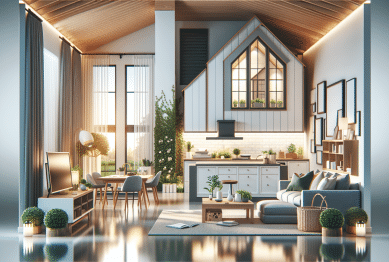Explore strategies for increasing your property’s worth, from eco-friendly updates to creative curb appeal. This guide reveals how thoughtful improvements in real estate & housing can unlock financial and personal benefits, whether you plan to sell or simply want a more rewarding living space.
Understanding What Influences Home Value
Determining what drives property value can feel like a puzzle. Neighborhood stability, proximity to services, and recent local sales are often the most influential factors. Not every home improvement translates directly to increased value, but location and demand frequently set the tone for a property’s financial potential. Understanding market trends helps with making sound decisions, and research is essential for homeowners considering both short- and long-term plans.
Appraisers and real estate agents use tangible and intangible criteria to evaluate a property. Factors like school district quality, public transit access, and local economic growth all play significant parts. These elements affect not only your current quality of life but also how much buyers are willing to pay. It’s worth taking the time to study the area, as buying in a thriving community can be one of the most impactful moves.
Market fluctuations are sometimes outside of your control, yet understanding them puts you in a better position for future gains. Homeowners who stay informed are usually more confident when adjusting their improvement plans or considering refinancing. The real estate marketplace changes over time, so keeping an eye on evolving buyer needs and popular upgrades can signal which investment moves have the most promise.
Eco-Friendly Improvements Make a Difference
Green upgrades are rising in popularity with both buyers and appraisers. Solar panels, energy-efficient windows, and improved insulation can increase the perceived and actual value of a property. In many regions, energy efficiency isn’t just an environmental concern but a market expectation. According to the U.S. Department of Energy, homes with green features often sell for more—a benefit that appeals to today’s sustainability-minded consumers (https://www.energy.gov/energysaver/energy-saver).
Smart thermostats, LED lighting, and water-saving appliances offer additional savings and comfort for residents. For sellers, these upgrades translate into valuable talking points that can set a property apart in crowded markets. Many programs exist to help homeowners finance energy-related upgrades, and some improvements may even qualify for local tax incentives or rebates if eligibility criteria are met.
The ripple effect of energy efficiency goes beyond lower monthly bills. Homes that are cheaper to run usually attract attention from cost-conscious buyers. Marketing a property as eco-friendly can draw a new set of prospects, sometimes speeding up the selling process. Even small eco-conscious changes often foster goodwill and make a lasting first impression on visitors and evaluators alike.
Enhancing Curb Appeal for Immediate Impact
A home’s first impression is often its most powerful marketing tool. Simple steps like repainting the front door, replacing outdated fixtures, and investing in landscaping instantly boost visual appeal. It’s well documented that homes with strong curb appeal tend to attract more interest, sometimes resulting in faster offers and higher values (https://www.nar.realtor/research-and-statistics/quick-real-estate-statistics).
Curb appeal isn’t just about appearances—maintained exteriors signal to buyers that the home has been cared for inside. Flowers, clean walkways, and updated lighting can all create a welcoming mood. Some real estate experts recommend focusing on low-cost, high-impact changes like fresh mulch, pressure washing, and adding native plants to gardens. All these transformations cater to both visual and practical buyer preferences.
Seasonal updates are another smart strategy. Matching outdoor décor to the season, keeping gutters clear, and refreshing house numbers help homes look their best year-round. These details may seem small, but collectively they can shape the stories buyers tell themselves when envisioning life in a new environment. Consistent maintenance is key, so establishing a routine pays off in the long run.
Smart Interior Updates Buyers Notice
Inside the home, certain updates attract more attention—and higher offers—than others. Kitchens and bathrooms consistently top the list of valuable renovation zones. Updated cabinetry, modern finishes, and new appliances stand out on listing photos and during tours, making the home memorable to prospective buyers. Even smaller fixes, like swapping hardware or fixtures, can make a room feel new again.
Layout flexibility is especially desirable. Open floor plans, extra storage, and multi-use spaces cater to many lifestyles. Current trends show that buyers look for homes that can easily adapt to their needs, from remote work to entertaining. Thoughtful use of neutral colors, durable flooring, and creative lighting also contribute to a welcoming ambiance that can enhance the perceived value of a home (https://extension.psu.edu/renovating-and-updating-a-house-to-sell).
Repairs remain important, too. Ensuring that systems like HVAC, electrical, and plumbing operate smoothly signals to buyers that problems are unlikely to arise after move-in. Addressing maintenance issues before listing prevents negative surprises during inspections and can streamline the selling process. Ultimately, homes that feel move-in ready generate more excitement and trust among shoppers.
Leveraging Smart Home Technology
Smart home features are increasingly sought after by buyers searching for convenience and security. Devices such as programmable thermostats, video doorbells, smart lighting, and security systems offer residents greater control. These enhancements are commonly mentioned in real estate listings as unique selling points and have been linked with higher buyer interest and satisfaction (https://www.realtor.com/advice/guide/smart-home-features-buyers-want).
Many smart devices are user-friendly and affordable, making them accessible even on moderate improvement budgets. Home automation can also support energy savings when integrated with heating, cooling, and lighting. As more consumers become accustomed to these technologies, their absence can make a property feel outdated. Staying current with trends can make a difference when the time comes to sell.
Privacy and compatibility remain top considerations for tech-savvy buyers. Opt for devices that balance convenience and data security. Providing documentation and instructions for new owners creates a seamless transition, further highlighting the value of recent smart upgrades. Ultimately, these features lay the groundwork for a more efficient, adaptable, and enjoyable living environment.
Extra Space and Adaptable Living Areas
Space, flexibility, and function often top buyer wishlists. Whether it’s a finished basement, a home office, or a versatile loft, having additional space gives families options for work, hobbies, and relaxation. Finished attics, bonus rooms, and even well-designed outdoor living areas can transform how a home is experienced (https://www.huduser.gov/portal/pdredge/pdr-edge-featd-article-040622.html).
Storage is another area that impacts perceived value. Built-in organizers, shelving, or creative closet systems make homes more attractive to those who want order with minimal effort. Market data shows that ample storage ranks high on buyer surveys, and families especially appreciate space to tuck away seasonal items or outdoor gear. Maximizing every usable inch is a growing trend.
The ability to reconfigure space matters now more than ever. Modular furnishings, retractable dividers, and moveable walls appeal to changing lifestyle needs. Homeowners who plan with flexibility in mind often find it easier to market their property when circumstances shift. After all, life evolves—and smart home design acknowledges this reality by allowing for ongoing adaptation.
References
1. U.S. Department of Energy. (n.d.). Energy Saver Guide. Retrieved from https://www.energy.gov/energysaver/energy-saver
2. National Association of Realtors. (n.d.). Quick Real Estate Statistics. Retrieved from https://www.nar.realtor/research-and-statistics/quick-real-estate-statistics
3. PennState Extension. (2016). Renovating and Updating a House to Sell. Retrieved from https://extension.psu.edu/renovating-and-updating-a-house-to-sell
4. Realtor.com. (n.d.). Smart Home Features Buyers Want. Retrieved from https://www.realtor.com/advice/guide/smart-home-features-buyers-want
5. HUD User. (2022). Expanding Housing Options with Accessory Dwelling Units. Retrieved from https://www.huduser.gov/portal/pdredge/pdr-edge-featd-article-040622.html
6. U.S. Department of Housing and Urban Development. (2016). Strategies for Success. Retrieved from https://www.huduser.gov/portal/publications/pdf/StrategyGuides2.pdf









